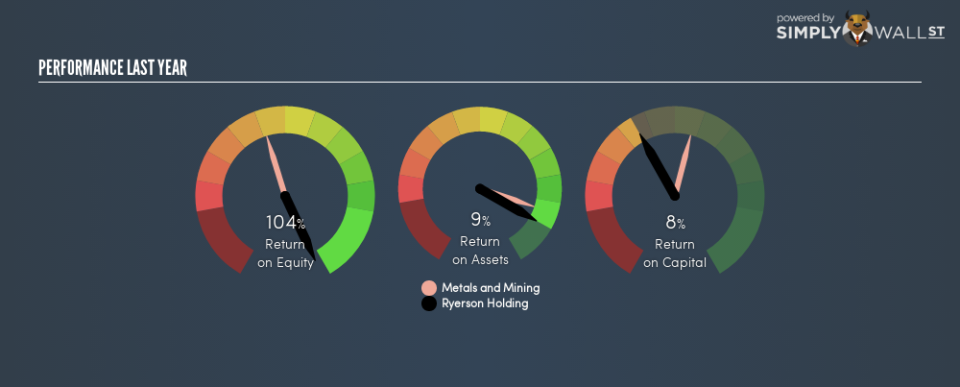Are Ryerson Holding Corporation’s (NYSE:RYI) Returns On Investment Worth Your While?

Today we are going to look at Ryerson Holding Corporation (NYSE:RYI) to see whether it might be an attractive investment prospect. Specifically, we’ll consider its Return On Capital Employed (ROCE), since that will give us an insight into how efficiently the business can generate profits from the capital it requires.
Firstly, we’ll go over how we calculate ROCE. Then we’ll compare its ROCE to similar companies. Finally, we’ll look at how its current liabilities affect its ROCE.
Understanding Return On Capital Employed (ROCE)
ROCE measures the amount of pre-tax profits a company can generate from the capital employed in its business. In general, businesses with a higher ROCE are usually better quality. Ultimately, it is a useful but imperfect metric. Renowned investment researcher Michael Mauboussin has suggested that a high ROCE can indicate that ‘one dollar invested in the company generates value of more than one dollar’.
So, How Do We Calculate ROCE?
The formula for calculating the return on capital employed is:
Return on Capital Employed = Earnings Before Interest and Tax (EBIT) ÷ (Total Assets – Current Liabilities)
Or for Ryerson Holding:
0.085 = US$111m ÷ (US$2.3b – US$656m) (Based on the trailing twelve months to September 2018.)
So, Ryerson Holding has an ROCE of 8.5%.
Check out our latest analysis for Ryerson Holding
Is Ryerson Holding’s ROCE Good?
ROCE is commonly used for comparing the performance of similar businesses. Using our data, Ryerson Holding’s ROCE appears to be around the 10% average of the Metals and Mining industry. Aside from the industry comparison, Ryerson Holding’s ROCE is mediocre in absolute terms, considering the risk of investing in stocks versus the safety of a bank account. Investors may wish to consider higher-performing investments.
As we can see, Ryerson Holding currently has an ROCE of 8.5%, less than the 14% it reported 3 years ago. This makes us wonder if the business is facing new challenges.
Remember that this metric is backwards looking – it shows what has happened in the past, and does not accurately predict the future. ROCE can be misleading for companies in cyclical industries, with returns looking impressive during the boom times, but very weak during the busts. This is because ROCE only looks at one year, instead of considering returns across a whole cycle. We note Ryerson Holding could be considered a cyclical business. Since the future is so important for investors, you should check out our free report on analyst forecasts for Ryerson Holding.
What Are Current Liabilities, And How Do They Affect Ryerson Holding’s ROCE?
Liabilities, such as supplier bills and bank overdrafts, are referred to as current liabilities if they need to be paid within 12 months. Due to the way the ROCE equation works, having large bills due in the near term can make it look as though a company has less capital employed, and thus a higher ROCE than usual. To check the impact of this, we calculate if a company has high current liabilities relative to its total assets.
Ryerson Holding has total assets of US$2.3b and current liabilities of US$656m. Therefore its current liabilities are equivalent to approximately 29% of its total assets. It is good to see a restrained amount of current liabilities, as this limits the effect on ROCE.
Our Take On Ryerson Holding’s ROCE
That said, Ryerson Holding’s ROCE is mediocre, there may be more attractive investments around. Of course you might be able to find a better stock than Ryerson Holding. So you may wish to see this free collection of other companies that have grown earnings strongly.
I will like Ryerson Holding better if I see some big insider buys. While we wait, check out this free list of growing companies with considerable, recent, insider buying.
To help readers see past the short term volatility of the financial market, we aim to bring you a long-term focused research analysis purely driven by fundamental data. Note that our analysis does not factor in the latest price-sensitive company announcements.
The author is an independent contributor and at the time of publication had no position in the stocks mentioned. For errors that warrant correction please contact the editor at editorial-team@simplywallst.com.

 Yahoo Finance
Yahoo Finance 
